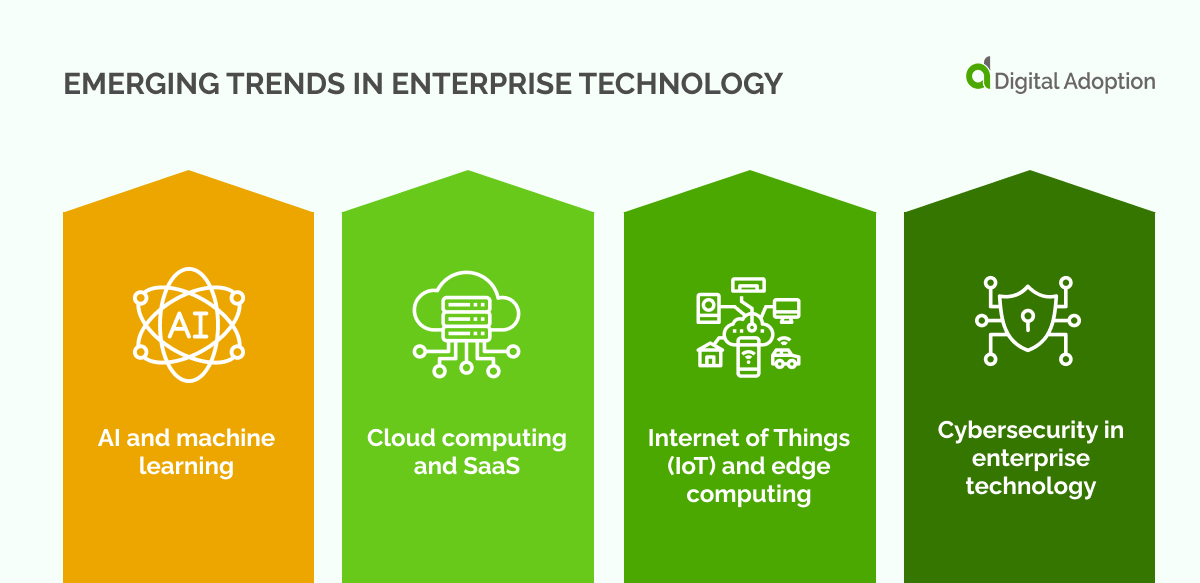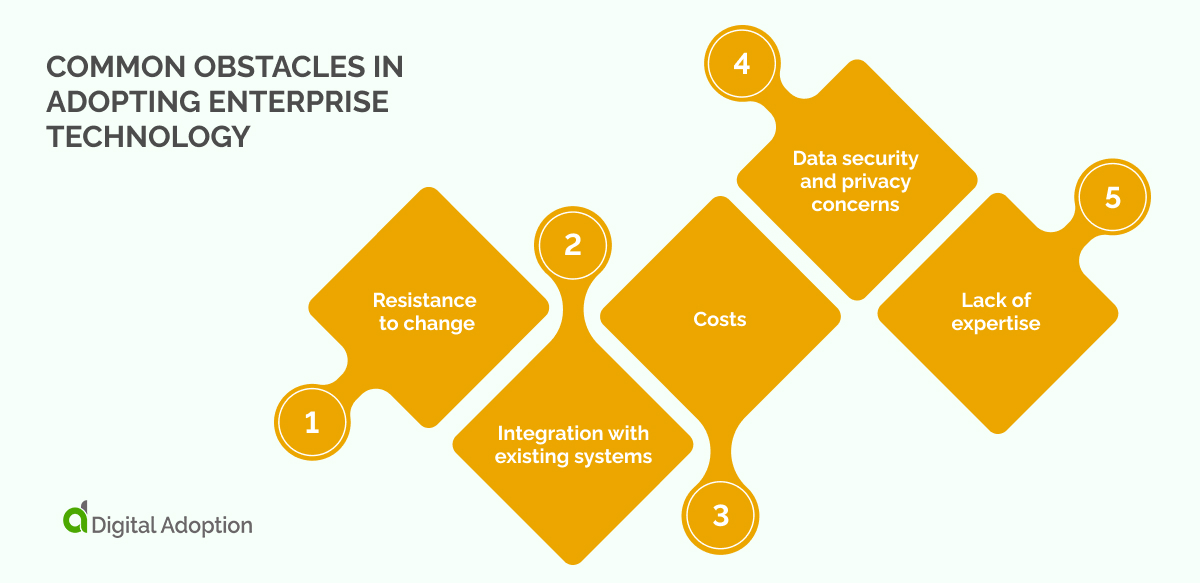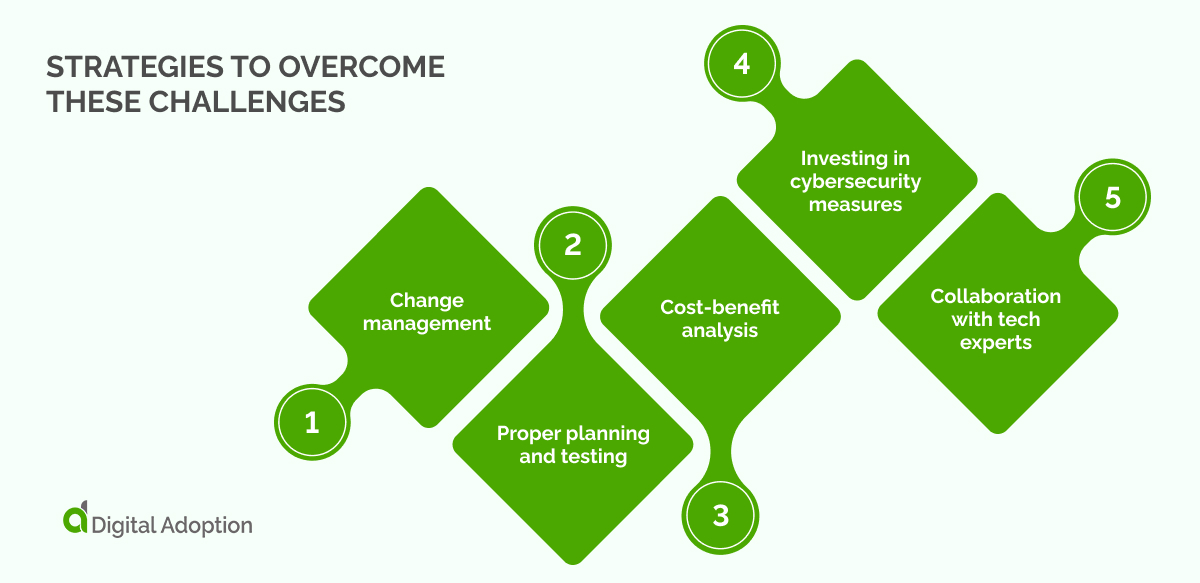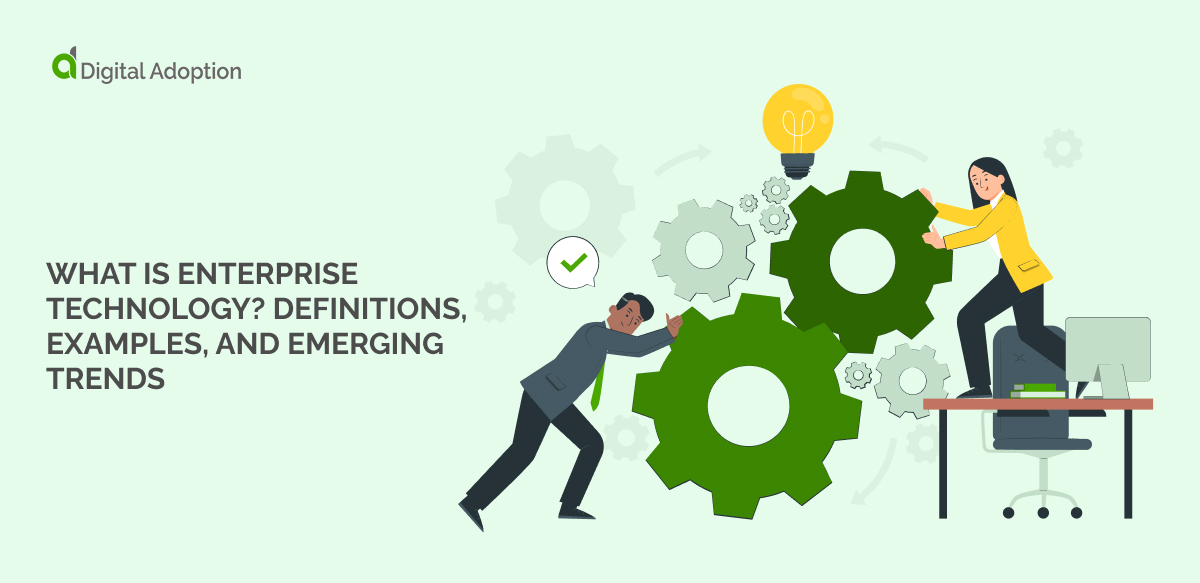Enterprise technology is the hardware and software businesses use to achieve business goals. Usually, enterprise technology is designed to be more cost-effective and scalable than consumer technology.
Enterprise technology is the lifeblood of modern businesses.
It’s virtually impossible to remain competitive without taking advantage of the benefits of enterprise technology.
However, incorporating enterprise technology into your business isn’t always straightforward. There’s a lot to think about when identifying and choosing the right digital tools.
Then, you must have a strategy to ensure successful digital adoption.
Furthermore, bringing new enterprise technology into the fold can completely change how your business operates— you must prepare for the impact of digital transformation in your organization.
In this article, we will explain everything you need to know about enterprise technology. By the time you’re done, you’ll be prepared to use enterprise technology to take your business to the next level.
Two core components of enterprise technology
Enterprise technology can broadly be separated into two categories: Software and hardware.
Within these two categories are virtually endless types of enterprise technology.
Enterprise software
Forming the backbone of the IT infrastructure in many businesses, these complex applications are designed to integrate and streamline various business processes, promoting efficiency and collaboration across different departments.
The most prominent types of enterprise software include:
ERP (Enterprise Resource Planning)
ERP systems allow you to manage essential business processes in real time.
These processes include inventory management, order processing, accounting, human resources, customer relationship management, and more.
By centralizing these resource allocation processes into one system, you can ensure data consistency and streamline workflows.
CRM (Customer Relationship Management)
CRM software is designed to help you manage interactions with current and potential customers.
Using a homegrown CRM, you can track and manage customer information, interactions, sales, and support, enhance customer service, and foster customer loyalty.
SCM (Supply Chain Management)
SCM software helps you manage the flow of goods, data, and finances, from acquiring raw materials to delivering the final product.
Using SCM software can reduce excess costs, improve customer service, increase operational efficiency, and accelerate delivery time.
Enterprise hardware
Enterprise hardware is physical technology equipment that a business uses to perform various functions.
It provides the fundamental infrastructure for running enterprise software and storing the vast data businesses generate.
The most common enterprise hardware you’ll find are:
Servers
Servers are powerful computers that provide shared resources, services, or applications to other computers, known as clients, over a network.
In a business context, servers host the databases and applications that enable your business operations and user functions.
Data centers
Data centers are physical facilities that organizations use to house their critical applications and data.
A data center’s design includes redundant or backup components for power, cooling, and networking capabilities to ensure the highest levels of business continuity.
Networking hardware
Networking hardware is the physical devices required for communication and interaction between devices on a computer network.
They provide the pathway for data to travel across the network, allowing users to access and share information seamlessly.
Examples include routers, switches, and firewalls.
Enterprise technology in the modern business landscape
The role of enterprise technology in today’s business landscape is prominent and influential.
The availability of enterprise solutions often shapes what businesses consider possible.
Why is it that enterprise technology has such a huge impact? What are the benefits enterprise tech offers which make it so indispensable?
The impact of enterprise technology on modern business operations
Enterprise technology has made a profound impact on the way businesses operate.
It has redefined the mechanics of business processes, enhanced efficiency, and optimized resource allocation.
It pays to be able to switch between different enterprise technologies with ease. Forrester reports that adaptive firms that recognize emerging customer needs and have a flexible technology foundation and operating model grow more than three times faster than their industry average.
Here’s a quick list of some of the most significant benefits of enterprise technology:
Streamlined operations
With tools like ERP and CRM, you can automate repetitive tasks, freeing employee time to focus on strategic initiatives.
Data-driven decision-making
You can gain insights from your data through advanced analytics and business intelligence software, enabling informed decision-making and predictive capabilities.
Enhanced collaboration
Enterprise technology facilitates seamless communication and collaboration, breaking down silos within your organization.
Improved customer service
Tools like CRM and AI-powered chatbots allow you to personalize the customer experience, resolve queries swiftly, and foster customer loyalty.
The role of enterprise technology in digital transformation
Enterprise technology plays a pivotal role in any company’s digital transformation journey.
The right enterprise solution can make or break a digital transformation effort, and often you’ll find that digital transformation strategic goals are designed around the available enterprise technology.
Here are a few of how enterprise technology is laying the foundation for digital transformation:
Innovation and competitive advantage
Adopting the latest enterprise technology allows you to innovate your processes, products, and services, giving you a competitive edge in the market.
Scalability
Cloud computing services and modular software architectures allow you to scale your operations up or down based on demand, leading to cost savings and improved resource management.
Integration and interoperability
Enterprise technology allows you to integrate various business functions, promoting interoperability and consistency across different business processes.
Remote work enablement
Amid the rise of remote work, enterprise technology enables employees to collaborate effectively and access necessary resources from anywhere, thus ensuring business continuity.
Emerging trends in enterprise technology

With the rapid evolution of technology, several trends are emerging in the enterprise technology landscape, significantly influencing how businesses operate.
Knowing these trends could help you know if and when to buy into them. Investing in new enterprise technology at the right moment can give you a chance to leapfrog the competition
Here are a few of the emerging trends in enterprise technology:
AI and machine learning
Artificial Intelligence (AI) and Machine Learning (ML) are transforming the enterprise landscape by automating routine tasks and generating valuable insights from vast data.
AI-driven applications assist in streamlining customer service through chatbots, improving decision-making with predictive analytics, and optimizing operational efficiency through an hyperautomation platform.
Machine learning, a subset of AI, enables systems to learn, interpret, and act on data independently, providing you with a powerful tool for identifying trends, predicting outcomes, and making data-driven decisions.
Cloud computing and SaaS
Cloud Computing and Software as a Service (SaaS) have become a staple in enterprise technology.
The cloud offers scalable and flexible resources that companies can leverage to store, manage, and process data, eliminating the need for physical infrastructure and lowering IT costs.
While cloud computing is fairly common nowadays, we think industry cloud is the next evolution of this enterprise technology.
However, SaaS allows businesses to access software applications over the Internet on a subscription basis, providing ease of use, affordability, and the ability to stay updated with the latest features and security measures.
Internet of Things (IoT) and edge computing
The Internet of Things (IoT) refers to the network of physical devices— such as sensors, appliances, and vehicles— connected to the Internet, collecting and sharing data.
IoT technology lets you gather real-time data, optimize operations, reduce costs, and enhance customer experiences.
Coupled with this, edge computing is gaining traction. It involves processing data closer to where it is generated (the “edge” of the network), reducing latency, improving speed, and enabling real-time analytics, which is especially valuable in IoT deployments.
Cybersecurity in enterprise technology
Cybersecurity has taken center stage in enterprise technology as businesses become increasingly digital and data-driven.
Cybersecurity tech protects enterprise systems, networks, and data from digital attacks, theft, and damage.
With cyber threats becoming more sophisticated, businesses invest in advanced cybersecurity measures such as AI-powered threat detection, blockchain for data integrity, and zero-trust security models.
This proactive approach to security ensures the protection of your sensitive business and customer data, maintains customer trust, and is critical to business and customer continuity planning.
The challenges (and solutions) in implementing enterprise technology
There are substantial benefits to adopting enterprise technology, but the process doesn’t come without challenges.
Perhaps the most considerable downside is the environmental impact of enterprise technology.
According to Mckinsey, in 2022, enterprise technology emitted about 350 to 400 megatons of carbon dioxide equivalent gases (CO2e), accounting for about 1 percent of total global greenhouse gas (GHG) emissions.
This may not sound like much, but it equals about half of the emissions from aviation or shipping and is the equivalent of the total carbon emitted by the United Kingdom.
This particular challenge is one that the industry as a whole needs to come together to solve. Aside from the environmental impact, there are several smaller-scale obstacles that you’ll likely also face.
Understanding these obstacles will help you navigate your digital transformation journey more effectively.
Common obstacles in adopting enterprise technology

Resistance to change
One of the most significant barriers to adopting new technologies is the resistance to change from employees.
It can stem from fear of the unknown, lack of understanding of the new technology, or concerns about job security.
Integration with existing systems
Incorporating new technology into existing IT systems can be complex and often poses compatibility issues.
Costs
Implementing new enterprise technologies can be expensive.
Not only the direct costs of purchasing the technology but also the indirect costs of training, maintenance, and potential downtime.
Data security and privacy concerns
With increasing reliance on digital technologies, businesses are more susceptible to cyber threats, causing data security and privacy concerns.
Lack of expertise
Some businesses may lack the technical skills to implement and manage new technologies effectively.
Strategies to overcome these challenges

Change management
Successful adoption of new technologies may require a cultural shift within your organization.
You can achieve this through effective change management strategies, like transparent communication about the benefits of the new technology, providing adequate training, and involving employees in the transition process.
Proper planning and testing
Prior to implementation, you should thoroughly plan and test the new technology in a controlled environment to ensure it integrates smoothly with existing systems.
Cost-benefit analysis
Conduct a comprehensive cost-benefit analysis to understand the return on investment (ROI) the new technology can offer.
The costs can’t be avoided, but this can help justify the initial costs associated with its implementation.
Investing in cybersecurity measures
You should prioritize investing in robust cybersecurity measures to protect sensitive data and alleviate security concerns.
This includes regular security audits, employing encryption technologies, and adhering to data compliance regulations.
Collaboration with tech experts
Collaborate with IT experts or third-party vendors with the knowledge and experience to help implement the new technology effectively.
This can help fill any skill gaps in your organization and ensure the new technology’s successful deployment.
Enterprise technology: Enabler, payload, and limitation all at once
The availability of enterprise technology permeates every facet of your business.
Established enterprise solutions enable you to drive efficiency and smooth operations.
Cutting-edge enterprise technology is the payload you want your digital transformation efforts to deliver.
And yet, the limitations of technology are the biggest hindrance to progress.
It’s important to understand that enterprise technology is the foundation upon which modern businesses are built.
Staying on the pulse of what emerging enterprise technologies are capable of is critical for any business leader looking for an opportunity to take a competitive lead.













